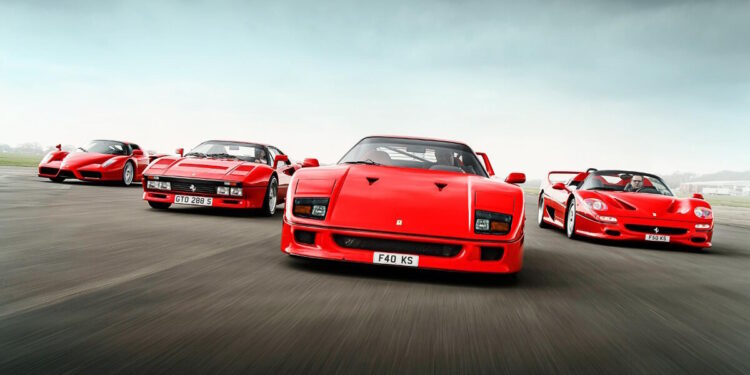Are you a fan of Ferrari and curious about the brand’s history? Look no further! In this post, we’ll delve into the fascinating history of Ferrari, from its early beginnings as a producer of sports cars to its evolution into a luxury carmaker and its embrace of modern technology.
From Enzo Ferrari’s racing roots to the company’s numerous victories on the track, the history of Ferrari is rich and storied. Follow along as we explore the evolution of this iconic brand and discover how it has changed over the years
The Early Years Of Ferrari
The History of Ferrari begins in 1947, when Enzo Ferrari founded the company in Maranello, Italy. Prior to starting Ferrari, Enzo had gained a reputation as a successful race car driver and founded Scuderia Ferrari, a company that provided race cars and drivers for Alfa Romeo.
In 1947, Enzo Ferrari unveiled the 125 S, the company’s first model. This car featured a V12 engine and a sleek, aerodynamic design, and it marked the beginning of Ferrari’s long and illustrious history. The 125 S was followed by a series of successful sports cars, such as the 166 and the 212, which helped to solidify Ferrari’s reputation as a leader in the automotive industry.
During this time, Ferrari also made a name for itself in motorsports. The company’s race cars dominated the track, winning numerous victories and championships in events such as the Formula 1 World Championship and the 24 Hours of Le Mans.
In the 1950s, Ferrari began expanding beyond sports cars and into the luxury car market. The company introduced models such as the 250 GT and the 400, which were designed for comfortable, long-distance travel. This marked the beginning of Ferrari’s evolution from a producer of sports cars to a luxury carmaker.
Racing Success
One of the most iconic moments in the History of Ferrari came in the 1950s when the company’s race cars dominated the Formula 1 World Championship. Drivers such as Alberto Ascari and Juan Manuel Fangio helped Ferrari earn multiple championships during this decade, solidifying the company’s place at the top of the sport.
Ferrari’s success in Formula 1 continued into the 1960s and 1970s, with drivers such as John Surtees, Niki Lauda, and Jody Scheckter helping the company earn additional championships. In addition to its success in Formula 1, Ferrari has also had numerous victories at the 24 Hours of Le Mans, one of the most prestigious endurance racing events in the world.
Ferrari’s racing successes have not been limited to the track, as the company has also had success in other motorsports disciplines. Ferrari has won numerous championships in sports car racing and touring car racing, further cementing its reputation as a leader in the automotive industry.
Ferraris Expansion into Luxury Cars
In the 1950s, Ferrari began branching out beyond sports cars and into the luxury car market. The company introduced models such as the 250 GT and the 400, which were designed for comfortable, long-distance travel. These luxury cars helped to diversify Ferrari’s product lineup and appeal to a wider audience.
In the 1960s and 1970s, Ferrari continued to expand its offerings, introducing models such as the 365 GT4 Berlinetta Boxer and the 400. These cars were known for their spacious and well-appointed interiors and smooth ride, making them a popular choice for those looking for a luxurious driving experience.
In the 21st century, Ferrari has continued to evolve and expand its product lineup. The company has introduced hybrid models, such as the LaFerrari, and has embraced cutting-edge materials and production techniques. While Ferrari is still known for its sports cars, the company has hinted at a future where it may focus more on electric vehicles. In 2019, Ferrari revealed its SF90 Stradale, a plug-in hybrid supercar, and it has announced plans to offer more hybrid and electric models in the coming years.
Modern Technology and Designs
In the 21st century, Ferrari has embraced modern technology and designs as it looks toward the future. One example of this is the company’s foray into hybrid and electric vehicles. In 2019, Ferrari revealed its SF90 Stradale, a plug-in hybrid supercar that features a powerful electric motor and a V8 engine. The SF90 Stradale represents the latest in Ferrari’s hybrid technology, and the company has announced plans to offer more hybrid and electric models in the coming years.
Ferrari has also embraced cutting-edge materials and production techniques as it looks to improve the performance and efficiency of its vehicles. The company has used materials such as carbon fiber and aluminum in its vehicles to help reduce weight and improve handling, and it has also embraced advanced manufacturing techniques such as 3D printing.
In addition to its focus on technology and performance, Ferrari has also continued to push the boundaries of design. The company has introduced models with futuristic and aerodynamic designs, such as the SF90 Stradale and the F8 Tributo, which showcase the company’s commitment to creating visually stunning and cutting-edge vehicles.
The Future of Ferrari
As we look towards the future, Ferrari has indicated that it may shift its focus more toward hybrid and electric vehicles. In 2019, the company revealed its SF90 Stradale, a plug-in hybrid supercar, and it has announced plans to offer more hybrid and electric models in the coming years. This shift towards electrification is in line with industry trends and represents the company’s commitment to sustainability and reducing its carbon footprint.
Ferrari has also hinted at the possibility of expanding its product lineup beyond sports cars and luxury vehicles. In recent years, the company has introduced models such as the GTC4Lusso T, a shooting brake-style vehicle, and the SF90 Stradale Spider, a convertible version of the SF90 Stradale. These vehicles suggest that Ferrari may be open to exploring new segments and expanding its offerings in the future


